Globe-trotting in Chicago
From Chinatown to Andersonville, these colorful neighborhoods are a window into other worlds.
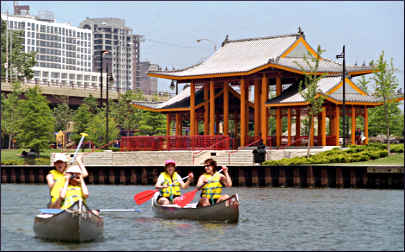
© Beth Gauper
One Memorial Day weekend, my friend Grace and I went to tour "ethnic" Chicago. But we'd only been there a few hours before we realized everything about Chicago is ethnic.
Chicago is a mosaic, a city of neighborhoods settled by waves of immigrants who arrived to dig its waterways, build its railroads and work in its slaughterhouses.
One of its first neighborhoods was Bridgeport, settled by Irish canal workers in the 1840s and the stronghold of Mayor Richard J. Daley and his son Richard M. Daley, the current mayor.
It was followed by Little Italy, Germantown, the Swedish enclave of Andersonville, Polish Village, Ukrainian Village, Chinatown, Greek Town, Bronzeville, the East Indian zone on Devon Avenue and Pilsen, a Czech quarter that now is heavily Hispanic.
Over the years, these neighborhoods have shifted and changed. Hard-working immigrants rode their business thoroughfares straight into the suburbs and were replaced by new immigrants.
In Andersonville, towheaded children play around the window boxes of a Persian restaurant near the Swedish American Museum. In Pilsen, the century-old Lithuanian church holds Masses in Spanish.
In India Town, the Croatian Cultural Center is flanked by the Delhi Darbar Kabab House and Gitel's Kosher Bakery.
Today, each neighborhood exudes the colors, smells and sounds of many nationalities, not one. Still, our ethnic-Chicago excursion gave us a good reason to venture beyond the Loop.
And when we arrived at our first destination, India Town, we felt as if we'd jumped not just the river, but the ocean.
"I'm looking around, and I don't see anyone who's not Indian," said Grace, whose parents emigrated from India. "How often would you have this experience in the Midwest?"
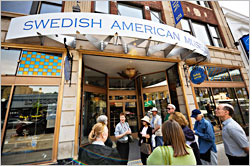
© Choose Chicago
Walking along, we looked up at the street signs and noticed that Devon Avenue had become Honorary Sheikh Mujib Way. Then Mohammed ali Jinnah Way. Then Gandhi Marg.
Women in saris and men, some in turbans, walked past store windows filled with jewelry, silk tunics, Bollywood videos and trays of brightly colored pastries.
Most successful Indians now live in the suburbs, but this is where they come to shop — and spend.
"See, this is the kind of store you'd see in India," Grace said wryly as we walked into Devi Jewelry. "This is one of the reasons people would come here; they go out to lunch and then buy themselves some diamonds."
An Indian man stood in the middle of the shop, good-naturedly watching as his wife and daughter huddled over the glass cases.
"I never have any fun here," he said with a rueful smile. "I get pulled in."
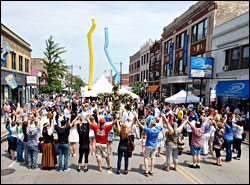
© Torsten Muller
Grace had to walk away from the $450 ring she was offered for $300, having no clue about whether she should bargain further.
"That's the thing about being first-generation American; you lose half your culture," she said. But at Taj Sari Palace, many of the richly colored silk saris were marked half-price, and she found a purple tunic and matching flared pants.
Nearby, a large black man, slated to be best man at an Indian friend's wedding, tried valiantly to fit into a cream brocade suitcoat.
It was Saturday, and the sidewalks were filled with shoppers. In a bakery, we inspected fudgelike squares of green and pumpkin-colored paste, pistachio balls topped with silver foil and spongy bright-yellow patties.
In the corner, a woman was spooning brown liquid into a hollowed-out pastry puff she called pani puri.
At the chat, or snack, counter, we ordered chai and split an order of samosas, chickpeas, yogurt, mint chutney and sev, which resembles tiny chow-mein noodles.
"From what I understand, this is street food," Grace said. "This is a very Indian thing to do: Take a rest and drink tea after all your hard shopping."
From India Town, we took the bus south to Andersonville, not expecting to see many remnants of the former Swedish community.
In the window of the Swedish American Museum, a flier advertised the twice-monthly Skandinavisk Happy Hour at a nearby bar.
At the Swedish Bakery, we bought a box of the chewy European almond tarts and horns that are so hard to find in this country. It's gone now, replaced by Lost Larson bakery, which specializes in Swedish breads and cakes.
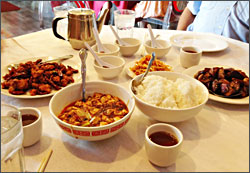
© Beth Gauper
The Ann Sather and Svea cafes had closed for the day, so we got back on the bus to Belmont and had dinner at the Ann Sather restaurant, known for its rosemaled walls and copious comfort food. My Swedish-born grandmother would've approved.
For the hamburger-and-fries crowd, eating may be the best way to become acquainted with another culture.
The next day, we headed south on the Red line to Chinatown and joined a horde at the Phoenix restaurant, known for its dim sum. As soon as we were seated, Chinese women arrived wheeling carts of bite-sized food on saucers and in bamboo baskets.
Since we wanted to try nearly everything, and the women seemed disappointed if we didn't choose something, we soon found ourselves surrounded by pork balls, potstickers, shrimp rolls and sweet sesame buns.
"We have to be more strategic and make them show us more stuff," Grace concluded.
Summoning the shreds of our appetites, we ordered a plate of the clams we saw on our neighbors' table; they came in the shell, cooked with bits of sausage and black beans in a chili-oil sauce. For dessert, we split three spires of springy coconut tofu.
We had no idea how much our eight little dishes would cost, but the bill was much lower than we'd thought it would be. Then, we wished we'd tried a few more.
Across the street at Chinatown Square, lined by fancifully sculpted animals of the Chinese calendar, we walked past speakers blasting disco music to browse among the mysterious bins of a Chinese grocery: dried lily bulbs, dried fish maw, preserved mulberry.
On Wentworth, we passed under the Chinatown Gate and onto a busy shopping avenue, mixing with tourists of many nationalities, Chinese-American teenagers sipping bubble tea and uniformed schoolchildren outside the Pui Tak Christian School.
Pagoda towers rose above the Pui Tak Center at the corner of Confucius Place and Honorary Dr. Sun Yat Sen Way. Adorned with art-nouveau tiles and bas-relief lotus blossoms, it was built in the 1920s by the neighborhood's principal tong society.
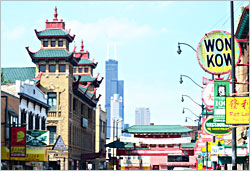
© Torsten Muller
Shop windows displayed jade elephants, carved Buddhas and bamboo plants coaxed into curlicues. Bakery cases were full of fruit tarts and strawberry tortes, as well as the less-familiar bean- and lotus-paste cakes, but we had no room left.
We'd meant to go on to Ukrainian Village for dinner, but the thought of kielbasa and pierogis made us groan.
Instead, we retreated to the lounge of Shaw's Crab House, where Grace managed to down a few oysters as we listened to live music.
In summer, Chicago's calendar is crammed with an amazing array of free concerts, dances, fairs and festivals that pay tribute to the many nationalities who have enriched the city.
Their contributions can be seen and heard any day of the year, however, in the wail of a blues saxophone or twang of a fiddle, and on the menu of every restaurant in town.
The neighborhoods are a fun destination, but their influences can be felt everywhere.
Trip Tips: Chicago neighborhoods
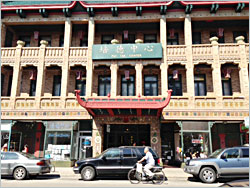
© Beth Gauper
Getting around: It's amazingly easy on the CTA, which operates subway/El trains and buses with remarkably friendly drivers.
Passes are for sale at airports, visitors centers, museums and Navy Pier.
Self-guided tours: Chicago's volunteer Greeters have curated these self-guided tours: Ukrainian Village, Pilsen and Chinatown.
Guided tours: The Chicago Architecture Foundation offers many walking tours of ethnic neighborhoods, including Andersonville (a pub crawl), Chinatown, Pilsen and Ukrainian Village.
It also offers a Discover Chicago's Neighborhoods bus tour that goes through Greektown, Little Italy, Pilsen, Chinatown and Bronzeville.
Chicago Food Planet offers a Chinatown Adventure Food Tour. For more, see Into the belly of Chicago.
Find out more about Chicago neighborhoods on the Choose Chicago website.
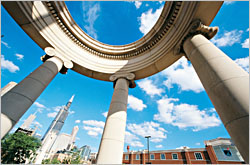
© Choose Chicago
Festivals
First weekend of May, Mexico Fest at Navy Pier.
Memorial Day weekend, Irish Fest at Gaelic Park in Oak Forest.
First weekend of June, Lincoln Park Greek Fest at St. George Greek Orthodox Church.
Mid-June, Midsommarfest in the Andersonville neighborhood.
Fourth of July weekend, (African-Caribbean) International Festival of Life in Washington Park.
July, Chinatown Summer Fair in Chinatown.
Last weekend of July, Fiesta del Sol in Pilsen.
August, Ginza Japanese Holiday Festival at the Midwest Buddhist Temple near Lincoln Park.
August, Bud Billiken Parade and Family Festival on the South Side, ending in Washington Park.
August, Taste of Greektown in Greektown.
August, Ukrainian Days in Ukrainian Village.
Labor Day weekend, Taste of Polonia at the Copernicus Center.
Tourism information: For more on planning a trip, see Chicago as you like it.
For Chicago tourism, call 312-567-8500.